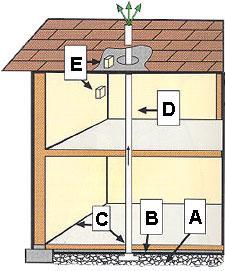How to Protect Your Family from Radon When Buying a Newly Built Home
On this page:
- What does EPA recommend?
- Why buy a radon-resistant home?
- What are radon-resistant features?
- What can you do?
- Need more information?
What does EPA recommend?
- If you are buying a home or selling your home, have it tested for radon.
- For a new home, ask if radon-resistant construction features were used and if the home has been tested.
- Fix the home if the radon level is 4 picocuries per liter, or pCi/L, or higher.
- Radon levels less than 4 pCi/L still pose a risk, and in many cases, may be reduced.
- Take steps to prevent device interference when conducting a radon test.
Why buy a radon-resistant home?
- The Techniques Work
Simple and inexpensive techniques reduce radon levels on average by 50%. The techniques may also lower levels of other soil gases and decrease moisture problems. - It's Cost Effective
Building in the features is much cheaper than fixing a radon problem later. - Save Money
The techniques described here also make your home more energy efficient and could provide you an average of $65 savings per year in your energy costs. - Upgrading is Easy If high levels of radon are found, a fan can easily be installed as part of the system for further radon reduction.
What are Radon-Resistant Features?
The techniques may vary for different foundations and site requirements, but the basic elements are:
| A. | Gas Permeable Layer This layer is placed beneath the slab or flooring system to allow the soil gas to move freely underneath the house. In many cases, the material used is a 4-inch layer of clean gravel. This gas-permeable layer is used only in homes with casement and slab-on-grade foundations; it is not used in homes with crawlspace foundations. |
 |
|---|---|---|
| B. | Plastic Sheeting Plastic sheeting seams sealed is placed on top of the gas permeable layer and under the slab to help prevent the soil gas from entering the home. In crawlspaces, the sheeting is placed over the crawlspace floor. |
|
| C. | Sealing and Caulking All below-grade openings in the concrete foundation floor are sealed to reduce soil gas entry into the home. |
|
| D. | Vent Pipe A 3- or 4-inch gas-tight or PVC pipe (or other gas-tight pipe) runs from the gas permeable layer through the house to the roof to safely vent radon and other soil gases above the house. |
|
| E. | Junction Box An electrical junction box is included in the attic to make the wiring and installation of a vent fan easier. For example, you decide to activate the passive system because your test result showed an elevated radon level (4 pCi/L or more). A separate junction box is placed in the living space to power the vent fan alarm. An alarm is installed along the vent fan to indicate when the vent fan is not operating properly. |
Did You Know?
- Radon is the second leading cause of lung cancer after smoking.
- High radon levels have been found in every state.
- Levels can vary widely, even from home to home in the same neighborhood.
- Radon levels can be lowered, and homes can be built radon-resistant.
What Can You Do?
Simple, inexpensive techniques can be used to lower radon levels and increase energy efficiency in your new home. Here are basic steps to follow when buying a new home.
1. Check Your Area's Radon Potential
Find out if you are buying a home in a high radon area. The Environmental Protection Agency's map of radon zones shows which areas have the greatest potential for elevated indoor radon readings. Homes in places with high radon potential, called Zone 1 areas, should be built with radon-resistant features.
2. Install a Radon Reduction System
Talk to your builder about installing a radon reduction system. You can obtain free copies of the EPA's Model Standards and architectural drawings and use them to explain the techniques to your builder. Let your builder know that the radon resistant features can be easily installed with common building practices and materials.
3. Remember: Test Your Home
Every new home should be tested for radon after occupancy. Test your home even if it has the radon resistant features. Test kits are inexpensive and may be purchased at your local hardware store. Or visit National Radon Services Program to order a test kit.
4. If Radon Levels Are Still High, Activate
If your home tests at 4.0 picoCuries per liter (pCi/L) or above, activate the system by installing an in-line fan. Call a local radon mitigator about installing the fan. Consult one or both of the national radon proficiency programs or your state radon contact for a list of qualified radon service professionals near you.
- For information about installing an in-line fan, see Home Buyer's and Seller's Guide to Radon.
Need More Information?
Free Information
Many publications are available to you. Here are just a few suggestions:
- EPA's Home Buyers and Sellers Guide to Radon
- EPA's Information about Local Radon Zones and State Contact Information
- Model Standards and Techniques for Control of Radon in New Residential Buildings
- developed by the U.S. Environmental Protection Agency and the building industry with details on how to install radon-resistant techniques in your new home.
- Architectural Drawings of Radon-Resistant Construction Techniques.
- You can also download a PDF version of the drawings: "Passive Radon Control Systems for New Construction," This PDF file includes (for one- and two-family dwellings):
- Passive radon control system
- Crawlspace radon control system
- Additional fan for active system
- You can also download a PDF version of the drawings: "Passive Radon Control Systems for New Construction," This PDF file includes (for one- and two-family dwellings):
